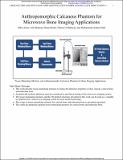Anthropomorphic calcaneus phantom for microwave bone imaging applications
Date
2020-10-09Author
Amin, Bilal
Shahzad, Atif
Kelly, Daniel
O'Halloran, Martin
Elahi, Adnan
Metadata
Show full item recordUsage
This item's downloads: 176 (view details)
Cited 1 times in Scopus (view citations)
Recommended Citation
Amin, Bilal, Shahzad, Atif, Kelly, Daniel, O'Halloran, Martin, & Elahi, Adnan. (2020). Anthropomorphic Calcaneus Phantom for Microwave Bone Imaging Applications. IEEE Journal of Electromagnetics, RF and Microwaves in Medicine and Biology. doi:10.1109/JERM.2020.3029938
Published Version
Abstract
Recent studies have found a significant dielectric contrast between healthy and osteoporotic human trabecular bones. This dielectric contrast can be exploited by microwave imaging for monitoring human bone health. The tissue mimicking phantoms play a vital role for preclinical testing of microwave imaging system. This paper presents anatomically realistic multi-layered 3D printed and carbon black based human calcaneus structure. The liquid and solid based tissue mimicking mixtures are also proposed to mimic the dielectric properties of skin, muscle, cortical bone, and trabecular bone. The liquid tissue mimicking mixtures are composed of Triton X-100, water, and salt, whereas the solid tissue mimicking mixtures are composed of carbon black, graphite, polyurethane, and isopropanol. The dielectric properties of the tissue mimicking mixtures were measured using an open-ended coaxial probe measurement technique across 0.5 8.5 GHz. The average percentage difference between the relative permittivity and conductivity of reference data and proposed liquid tissue mimicking mixtures was found to be 7.8% and 9.6% for skin, 0.38% and 14% for muscle, 9.6% and 5% for cortical bone, and 3.4% and 2.4 % for trabecular bone, respectively, across 0.5 8.5 GHz. For solid tissue mimicking mixtures, this difference was found to be 3.93% and 0.64% for skin, 6.13% and 9.21% for cortical bone, and 10.66% and 41.82% for trabecular bone, respectively for relative permittivity and conductivity. The proposed tissue mimicking mixtures along with 3D printed structures can be used as a valuable test platform for microwave bone imaging system development.


